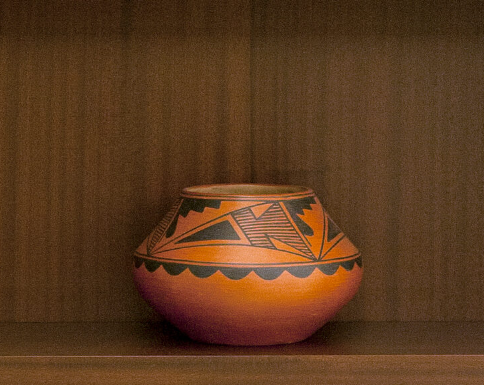Artist: Maria Montoya Martinez
Maria’s love of pottery began at an early age as she watched her aunt making pots. At that time, women in the pueblo still knew how to make pots, but it was no longer a necessity. Tinware and enamelware had replaced traditional cooking pots for daily meals. The art of pottery making was about to slip away. In 1908, Dr. Edgar Lee Hewett led an archaeological excavation of an ancient pueblo site near San Ildefonso. Afterward, he asked Maria to create full-scale examples of the centuries-old pottery he had discovered for display at the Museum of New Mexico. Maria and her husband, Julian, demonstrated their pottery techniques for the 1904 St. Louis World’s Fair, the 1914 Panama-California Exposition in San Diego and the 1934 Chicago World’s Fair. After Julian died, Maria began making pots with her daughter-in-law, Santana, and later with her son, Popovi Da. Maria is credited with reviving the tradition of Southwest pottery. In the 1930s, Maria and her family befriended Kiowa artist Jack Hokeah, see page 141. He had traveled to New Mexico for the Intertribal Indian Ceremonials and secured work painting murals at the Santa Fe Indian School, along with Maria’s husband Julian. Around this time, the Martinez’s oldest sons were getting married and starting families of their own and their two younger sons had left for college. Hokeah studied pottery with Maria and she adopted him into their family. This pot is an early polychrome creation, before Maria began doing the black pots which made her famous. A potter’s wheel was not used to make these pieces, instead the pots are formed using a coil technique. Long coils of clay are circled around the base of the pot and then blended together to make the walls. After the desired height is reached, the walls are smoothed and shaped using pieces of gourd. This pot was included in the shipment of five barrels the Oklahoma Historical Society purchased from the Old Santa Fe Trading Post in 1928. It is now on permanent loan to the Oklahoma Judicial Center collection.
